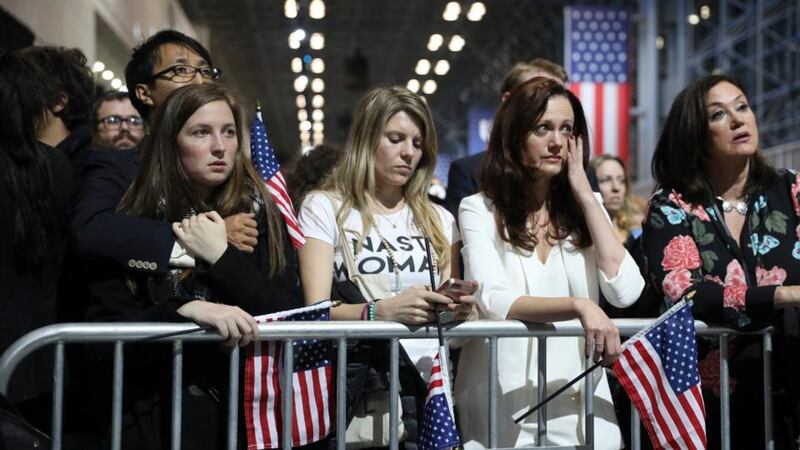Almost 18 months since the world awoke to the stunning news that Donald Trump was to be the 45th president of the United States, the story of the 2016 election remains as compelling as ever.
The question played on by the title of Hillary Clinton's book about the campaign, What Happened, continues to be asked as the US comes to the terms with both the Trump phenomenon and the failure of pollsters, the media and political professionals to predict his victory.
The New York Times journalist Amy Chozick is the latest writer to tackle the topic. She was assigned to cover Clinton by the newspaper's then editor, Jill Abramson, in 2013, almost two years before the former secretary of state announced she would run for the White House again.
Hi @amychozick! The 1st line (“Things were already looking bad when Chelsea Clinton popped the Champagne”) is false. I would have been happy to tell you that if you’d asked, which you didn’t. Looking forward to the correction once you fact check. Thanks! https://t.co/gqppfDEEW1
— Chelsea Clinton (@ChelseaClinton) 20 April 2018
Chozick argues that it was Clinton who had a public-relations problem, one that stopped her real self from ever shining through
Already the book has prompted a piqued reaction from Chelsea Clinton, the candidate's daughter, who denounced its depiction of her on Twitter this week. But while Chasing Hillary sheds fascinating new light on the Clinton campaign, its real focus is the relationship between Clinton and the press.
At a time when relations between the current occupant of the White House and the fourth estate are at an all-time low, Chozick argues that it was Clinton who had a public-relations problem, one that stopped her real self from ever shining through.
Chozick brings us into the heart of covering a presidential campaign, from her personal tensions with Clinton's staff to her deteriorating relationship with the candidate. Clinton and her team frequently complained to senior editors about Chozick's coverage – part of a long-standing Clinton grievance against the New York Times that Chozick says stretched back to the 1990s.
Clinton later said the New York Times covered her use of a personal email server for state-department communications – the controversy that James Comey then raised, as FBI director, shortly before the election – "like it was Pearl Harbor", accusing the Times and other mainstream media of falsely equating her behaviour with her rival's, and so helping to elect him.
But Chozick argues that Clinton was her own worst enemy. “We did all hyperventilate over her emails. But Hillary and her campaign never had a strategy to change the conversation.”

Chozick submitted 47 requests for an interview, but, she says, Clinton remained evasive. In contrast Trump called Chozick, as he did many other journalists, directly. Noting in March 2016 that it had been 84 days since Clinton had held a press conference, Chozick asks: “How could we communicate Hillary’s funny, wicked and wacky side to voters if we never saw it for ourselves?”
As she doggedly tries to connect with Clinton, whose blond hair and trouser suit are always a step ahead, the reporter is wickedly critical of the would-be president. She describes Clinton “flipping steaks with a forced grin” as she announces her presidency, and meeting supporters at town halls in Iowa with a perma-smile – “I love that outfit!” she says, tugging at a woman’s knitted scarf.
Bill Clinton looms in the background, treated by his wife’s campaign team as “a gifted but problematic child who needed to be kept busy”. There are also some Irish cameos, such as that of the “eligible bachelor” John Fitzpatrick, of Fitzpatrick Hotels in Manhattan, and Declan Kelly, long-time Clinton aide – and brother of Alan Kelly, the Labour Party TD – whom Chozick tells us Clinton’s people refer to as the “f***ing leprechaun”.
In the final 10 days the only unifying force behind Clinton's campaign is her obvious desire to get the whole thing over with, says Chozick
But Chozick is equally blunt about her own neuroses and the failings of the media. As she tries to keep her personal priorities in check she battles with her professional insecurities – “they’ve gotten into my head and I let them”, she says of Clinton’s campaign staff, who tell her that nobody takes her seriously. At one point she starts dreaming about Hillary Clinton; at another she decides she had better not get a blow-dry, in case the candidate doesn’t recognise her.
She also probes the way the New York Times and other media handle the email scandal, wondering whether she and other journalists had become unwitting Russian accomplices in their use of material that Moscow is believed to have given to WikiLeaks. The media's belatedness in taking seriously Trump's candidacy also surfaces. "We've enough candidates to cover," one editor says. "Let the TV writers do it," is the response in the newsroom when Trump announces he is running.
As the election approaches the sense of doom is palpable. In the final 10 days the only unifying force behind Clinton’s campaign is “her obvious desire to get the whole thing over with”, says Chozick. But no one sees Trump’s victory coming. “Until that last day, I hadn’t felt as though I was covering a winning campaign. Not that I thought Trump would win. I believed in the data,” she writes early in the book.
Ultimately, as Chasing Hillary shows, Clinton remained as elusive to the public as to those who covered her most closely – one of the many reasons that, against all odds, her presidency wasn't to be.











